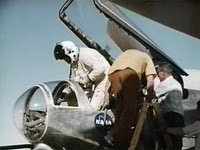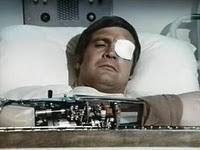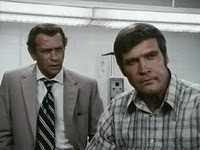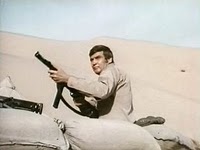LINKS
- Attack of the 50-Year-Old Comics
- Super-Team Family: The Lost Issues
- Mark Evanier's Blog
- Plaid Stallions
- Star Trek Fact Check
- The Suits of James Bond
- Wild About Harry (Houdini)
In the spring of 1973, ABC television aired a made-for-TV adaptation of Martin Caidin’s novel, “Cyborg,” introducing Steve Austin to millions of viewers and launching a 70s pop culture phenomenon.
 The film opens with ex-astronaut Austin suiting up to pilot an experimental aircraft at a desert testing ground, while hundreds of miles away in Washington, DC, OSO director Oliver Spencer holds a secret meeting to propose the creation of a top-secret superweapon…a cyborg, part man and part machine. The estimated cost? Roughly six million dollars.
The film opens with ex-astronaut Austin suiting up to pilot an experimental aircraft at a desert testing ground, while hundreds of miles away in Washington, DC, OSO director Oliver Spencer holds a secret meeting to propose the creation of a top-secret superweapon…a cyborg, part man and part machine. The estimated cost? Roughly six million dollars.
“Will you ask for volunteers?” someone asks. “No….” says Spencer casually. “Accidents happen all the time. We’ll just start with scrap.”
Spencer gets his human scrap pile when Austin’s aircraft suffers a catastrophic crash, leaving him mutilated and near death, a triple amputee with extensive internal injuries. Judging Austin a suitable candidate for his project, Spencer directs the brilliant surgeon Dr Rudy Wells to make good on his theories of “bionics,” replacing human parts with mechanical duplicates capable of doing anything the originals could, and more.
 Austin has a hard time accepting his fate, at first repulsed by the sight of his new limbs, but in time he adapts to his bionics and the amazing power they give him. Then the other shoe falls as Spencer asks Steve to make good on his debt by taking on a special covert mission for the OSO.
Austin has a hard time accepting his fate, at first repulsed by the sight of his new limbs, but in time he adapts to his bionics and the amazing power they give him. Then the other shoe falls as Spencer asks Steve to make good on his debt by taking on a special covert mission for the OSO.
Steve reluctantly agrees and parachutes into an Arabian desert on a mission to rescue a kidnapped Israeli dignitary. He soon finds out what Spencer knew all along; the man he’s been sent to rescue is already dead. With Austin now in the hands of Arab terrorists, Spencer — back in Washington — confesses his duplicity to Rudy Wells: This has all been a test to determine Austin’s resourcefulness and will to survive. “If he fails, I can always build another cyborg. But if he survives — which appears to be doubtful — then I know I have my man.”
Steve does survive, of course, escaping his captors and blowing up half the terrorist camp on his way out. Back in the States, Dr Wells induces a sleep state in Steve to speed his recovery from injuries, and Spencer asks if it’s possible to just keep him asleep until he’s needed again, a suggestion Rudy finds abhorrent.
“Cyborg” was a ratings hit when it aired, earning a Hugo Award nomination and spawning two sequel TV movies and a hit weekly series that ran for five years. As a medical/sci-fi drama it remains an entertaining bit of television. For fans, it offers some fascinating twists on the Six Million Dollar Man story as we’d come to know it.
For one thing, Oscar Goldman is nowhere in sight, replaced here by OSO chief Oliver Spencer, a hard-hearted, ruthless man on the surface but — as played by the late great Darren McGavin — one we sense is more complex than he first seems. Spencer hits Steve with what we might today call “tough love,” refusing to show him any pity or tiptoe around his feelings, and forcing him to accept his new life as a cyborg and put his abilities to use in a cause.
 Someone — possibly McGavin himself — elected to have Spencer walk with a limp and carry a cane. No reference is made to what led to this infirmity, but it adds a subtle subtext to Spencer’s plot to build a bionic man, and perhaps to his gruff demeanor. “You’re more of a robot than I am,” Steve says bitterly. “You should have been me.” Without missing a bit, Spencer agrees: “Yes, that would have been simpler,” earning a surprised look from Steve. Harsh as he is, Spencer emerges as a fascinating character who never fails to make sparks with Austin in their scenes together. Arrogant and tactless, he’s like a spiritual forefather of Hugh Laurie’s “House” character. It would’ve been fun to see Spencer hang around, rather than step aside for the comparatively bland Oscar Goldman, but then if McGavin had stayed on we’d never have gotten “The Night Stalker.”
Someone — possibly McGavin himself — elected to have Spencer walk with a limp and carry a cane. No reference is made to what led to this infirmity, but it adds a subtle subtext to Spencer’s plot to build a bionic man, and perhaps to his gruff demeanor. “You’re more of a robot than I am,” Steve says bitterly. “You should have been me.” Without missing a bit, Spencer agrees: “Yes, that would have been simpler,” earning a surprised look from Steve. Harsh as he is, Spencer emerges as a fascinating character who never fails to make sparks with Austin in their scenes together. Arrogant and tactless, he’s like a spiritual forefather of Hugh Laurie’s “House” character. It would’ve been fun to see Spencer hang around, rather than step aside for the comparatively bland Oscar Goldman, but then if McGavin had stayed on we’d never have gotten “The Night Stalker.”
Still not quite the self-confident, square-jawed hero who will launch a thousand toys, Steve Austin in this film is a complex character. We first see him sauntering casually onto the tarmac of an airfield, nearly late for a test flight. His mind is on his days as an astronaut, and we sense his life is starting to drift off target. After the crash, he attempts suicide on finding himself a triple amputee. Later, even though his bionic limbs look identical to the originals, he still considers himself a freak, and when he rips open his bionic arm while rescuing a child from a mangled car, the child’s mother reinforces his fears, asking in revulsion, “What are you?” These themes of alienation and self-loathing will continue to some degree in the next telefilm, but quickly fade as the series gets under way and Steve — and his audience — comes to see his bionic enhancements as a net gain, and even a blessing.
For some reason, the film deviates from the novel by making Austin a “civilian member” of the space program, rather than an Air Force Colonel. Maybe this is to rationalize Spencer’s scheme at the end of the film, where he sets up an elaborate test of Steve’s patriotism and combat readiness. Presumably if he were an Air Force officer, those traits would be a given. Maybe it’s a reflection of the Vietnam War, still in progress when the film aired; it’s possible someone thought a story about a military man made into a super fighting machine wouldn’t generate as much sympathy as that of a civilian forced into government service by circumstances beyond his control.
 This first film is also more violent than the series would be. On reluctantly agreeing to take Spencer’s assignment, Steve says, “I don’t want to kill people.” Nonetheless, Steve racks up an impressive body count in this film, taking out terrorists with a machine gun and grenades in precisely the sort of high-firepower climax the later series would studiously avoid.
This first film is also more violent than the series would be. On reluctantly agreeing to take Spencer’s assignment, Steve says, “I don’t want to kill people.” Nonetheless, Steve racks up an impressive body count in this film, taking out terrorists with a machine gun and grenades in precisely the sort of high-firepower climax the later series would studiously avoid.
Nearly 35 years after it first aired, “Cyborg” (aka “The Six Million Dollar Man”) still holds up as compelling drama and thought-provoking sci-fi. As an action flic, the pacing can be a bit slow, and the anemic musical score by Gil Melle can’t touch the heroic, jazzy coolness of Oliver Nelson’s work on the series proper, but all in all, this is a solid 90 minutes or so of entertainment. IF, that is, you can get your hands on it. Hopefully Universal will work out the legal issues keeping this and the rest of the Six Million Dollar Man saga out of reach of DVD collectors here in the United States.
Steve Austin. Better, Stronger, Faster. And the first inductee in my Pop Culture Hero Hall of Fame.
About Martin Caidin, the author of Cyborg:
I actually had the pleasure of reading his Indiana Jones tie-in novel, “Indiana Jones and the Air Pirates” (written to cash in to the media blitz after Last Crusade came out). It’s funny: the pulps were written by guys that hacked things out at a penny a word, whereas the Indiana Jones books were written by people that had long experience with writing including things like travel journalism.
Anyway, “Air Pirates” was one of the few books about aviation that I’ve ever read that show the author probably was a pilot himself – everything, even the jargon, shows someone that is familiar with the experience of flight. Which is about right: Martin Caidin was a pilot. This book was to aviation adventure what “King Solomon’s Mines” was to African exploration and had a real ring of authenticity.
If you’ve read even a single Doc Savage novel in your life, you’d probably be able to call the events of the story: the supposed alien menace actually is a bunch of criminals, and the “miraculous” technology they have is actually a cover for something quite ordinary and plausible…although this time I was totally blindsided by the exact means. Did you know that the jet engine had been invented all the way back in 1930?
I read “Cyborg” on an airplane. The twitchy South African tourist next to me asked what the book I was reading was about, and I told him that it was about a guy that gets horribly mangled and amputated after a plane crash.
Though the plane was chilly due to the altitude, after that conversation, I was warm all through the flight.
Actually, since the menace was a super-criminal organization with superior science and a frightening, world-threatening goal, and the hero was a super-spy that had command of a team of allies (including a solitary feisty female with a problem taking orders) it wouldn’t surprise me in the least if it actually turned out that “Air Pirates” was actually something that Caidin originally wrote to be a Doc Savage novel, and when he was asked to do an Indy book, he filed off the serial numbers and hastily rewrote it starring Dr. Jones.
By the way, Indiana Jones’s past with espionage organizations was a huge part of his character in the novels but never appeared in the movies…until Crystal Skull. Apparently, somebody had been reading the tie-ins!
Thanks for the tip; I’ve often considered trying out the Indy novels, but never knew which to start with. Now I do.
“Cyborg” was great in the way “Jurassic Park” was; it made everything sound so plausible you finally let yourself believe it all (something totally lost in Spielberg’s movie, which reduces the “science” to a two-minute animated filmstrip so they can get on with the monster-fighting). Little things made it for me, like the way the bionics experts botch the first attempt at Steve’s arm (in the book, it was the left one) because they model it after his surviving right arm, which is naturally more muscularly developed as a result of his using it to control jets. Also, the frank admission by the surgeons that they’re nowhere near being able to duplicate the vision of a real eye, so he remains blind on that side (His replacement eye is a camera; he takes pictures by pressing his temple, and pops the eye out to get the film developed!). Also while he can smash through a wall with his new arm, he can’t lift cars over his head, and while he can run forever, he can’t go at 60mph.
The only other Caidin novel I remember reading was “Final Countdown.” I still don’t know if it was a novel they made a movie from, or a movie tie-in he wrote to market the film, but it was pretty loopy. If you haven’t seen/read it, it involves a nuclear aircraft carrier going through a time warp to the days before Pearl Harbor, and the captain wrestling with a dilemma; he can either (a) save Hawaii by destroying the Japanese invaders with his superior technology, in the process probably screwing up history in unimaginable ways or (b) let history take its course, which technically would violate his oath to defend his country. Actually, that makes it sound a lot more cerebral than it was; basically it amounted to a Navy recruiting film, or what passed for one before Top Gun came along.
Still haven’t seen “Crystal Skull,” if you can believe it. I’ll put it in the NetFlix queue.